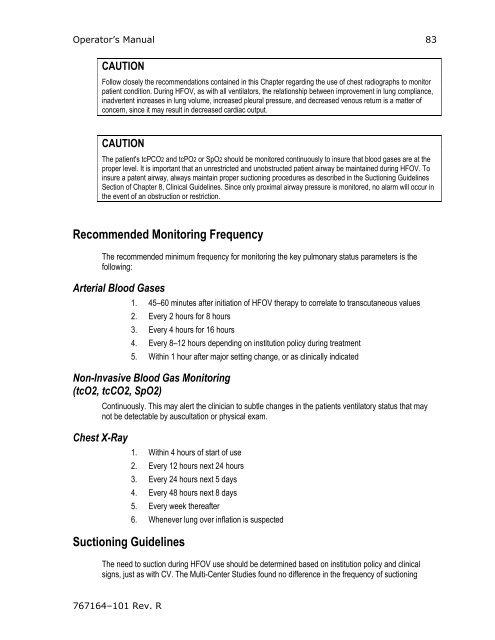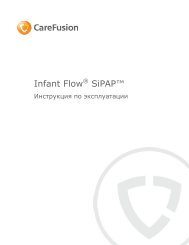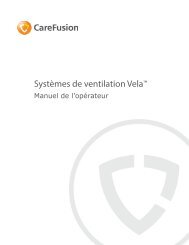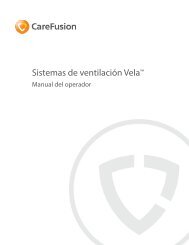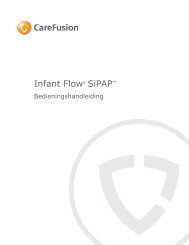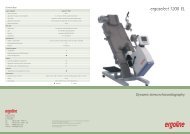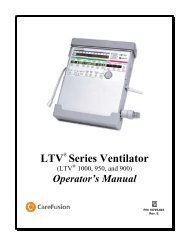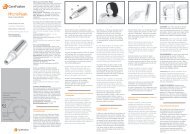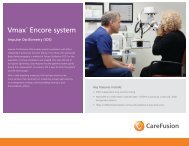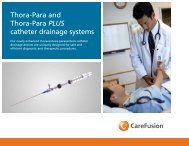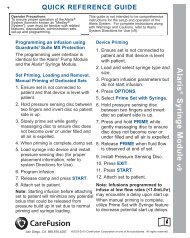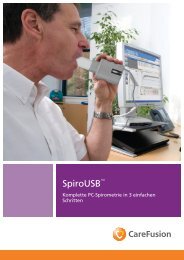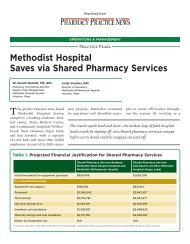3100B HFOV Operator Manual - CareFusion
3100B HFOV Operator Manual - CareFusion
3100B HFOV Operator Manual - CareFusion
Create successful ePaper yourself
Turn your PDF publications into a flip-book with our unique Google optimized e-Paper software.
<strong>Operator</strong>’s <strong>Manual</strong> 83<br />
CAUTION<br />
Follow closely the recommendations contained in this Chapter regarding the use of chest radiographs to monitor<br />
patient condition. During <strong>HFOV</strong>, as with all ventilators, the relationship between improvement in lung compliance,<br />
inadvertent increases in lung volume, increased pleural pressure, and decreased venous return is a matter of<br />
concern, since it may result in decreased cardiac output.<br />
CAUTION<br />
The patient's tcPCO2 and tcPO2 or SpO2 should be monitored continuously to insure that blood gases are at the<br />
proper level. It is important that an unrestricted and unobstructed patient airway be maintained during <strong>HFOV</strong>. To<br />
insure a patent airway, always maintain proper suctioning procedures as described in the Suctioning Guidelines<br />
Section of Chapter 8, Clinical Guidelines. Since only proximal airway pressure is monitored, no alarm will occur in<br />
the event of an obstruction or restriction.<br />
Recommended Monitoring Frequency<br />
The recommended minimum frequency for monitoring the key pulmonary status parameters is the<br />
following:<br />
Arterial Blood Gases<br />
1. 45–60 minutes after initiation of <strong>HFOV</strong> therapy to correlate to transcutaneous values<br />
2. Every 2 hours for 8 hours<br />
3. Every 4 hours for 16 hours<br />
4. Every 8–12 hours depending on institution policy during treatment<br />
5. Within 1 hour after major setting change, or as clinically indicated<br />
Non-Invasive Blood Gas Monitoring<br />
(tcO2, tcCO2, SpO2)<br />
Continuously. This may alert the clinician to subtle changes in the patients ventilatory status that may<br />
not be detectable by auscultation or physical exam.<br />
Chest X-Ray<br />
1. Within 4 hours of start of use<br />
2. Every 12 hours next 24 hours<br />
3. Every 24 hours next 5 days<br />
4. Every 48 hours next 8 days<br />
5. Every week thereafter<br />
6. Whenever lung over inflation is suspected<br />
Suctioning Guidelines<br />
The need to suction during <strong>HFOV</strong> use should be determined based on institution policy and clinical<br />
signs, just as with CV. The Multi-Center Studies found no difference in the frequency of suctioning<br />
767164–101 Rev. R


